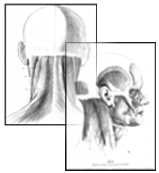Dizziness and nausea
When you experience dizziness you can also become nauseated. In connection to a more severe rotational vertigo, you might even vomit. When your balance gets disturbed and you lose control, that generates nausea.
The nerve “Vagus” is overstimulated and is part of the somatic nervous system that is linked to stress and activation. When the causes of the symptom for dizziness are eliminated, the vertigo symptom decreases / disappears and so does the nausea.
Dizziness and stress treatment
As dizziness and vertigo often are connected to stress and neck problems, they can be eliminated by correcting the causes that trigger the dizziness and vertigo. With insight and measures to minimize stress causes, in combination with stretching exercises, the state of tension reduces, which in turn decreases – to eliminate – the symptoms of dizziness and vertigo. You get simple tips and advice through our step 1 Help for self-help online – where you get the tools to treat your vertigo.
Benign Paroxysmal Positional Vertigo (BPPV) – Crystals in the ear
Benign Paroxysmal Positional Vertigo (BPPV), is explained by the theory that small crystals in the inner ear loosened and ended up wrong in the snail’s arch ducts. Often Hallpike’s maneuver is recommended to shake the crystals right again. Hallpike maneuver is carried out by rapid movements with the head and torso which is supposed to detach the crystals so that they end up right.
Since the diagnosis is only a theory which cannot be clinically verified, one should also take into account that in the same maneuver, the musculature of the upper neck and lower scull is also affected as a type of auto stretching. It may be that this exercise gives positive results on dizziness and vertigo rather than crystals getting placed right.
The experience of vertigo can last for a few seconds to several minutes and vary in intensity. People describe their dizziness and vertigo as being inside a jar, taking missteps, and feeling like the surface is uneven, the room is spinning and it feels impossible to stay upright. Regardless of intensity, there are connections to more or less severe level of muscle tension in the neck and shoulders. The vertigo experience can be triggered (influenced) by various head movements such as looking quickly to the left or right side (e.g. before crossing a road), looking backwards (e.g. in connection to backing the car), looking upwards (e.g. picking something out of a cupboard), look down (e.g. in connection with going down a staircase). In experience of vertigo, the eyes moves rapidly to gain focus – which is also called nystagmus. When neck tension and nystagmus affect the focus negatively, we experience dizziness – vertigo.
It is very common to be diagnosed with Benign Paroxysmal Positional Vertigo (BPPV) in the case of symptoms of vertigo. But since this cannot be determined clinically, other causes should be investigated. It is common, however, for vertigo of different character, such as rotational, nautical, drip vertigo and feeling of unsteadiness, to have strong connections to muscle tension in the neck. Patients who experience different kinds of vertigo often describe neck problems as well.
Benign Paroxysmal Positional Vertigo (BPPV) Treatment
There are ways to treat dizziness and vertigo no matter how it is experienced, but it should be determined whether the inconvenience can be linked to stress, neck problems and muscle tension. By taking part of our questionnaire, you get a clearer insight into your particular symptoms. Try our Help for Self-help online where you get help to analyze your dizziness.

